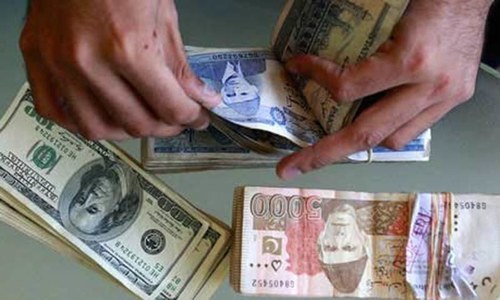ISLAMABAD: Amid criticism over abrupt devaluations, the government and the State Bank of Pakistan (SBP) on Friday said the country’s exchange rate has now reached ‘near to equilibrium’ and is reflective of the market conditions.
At a meeting of the Senate Standing Committee on Finance & Revenue, SBP Governor Tariq Bajwa reluctantly agreed to discuss recent depreciation of rupee against dollar after his assertions to hold in-camera briefing were rejected by the panel.
Bajwa explained that exchange rates generally move on demand and supply in the market and the key reason behind the recent devaluation was the last fiscal year’s $19-billion current account deficit.
“Such a large gap had to be met from somewhere,” said the governor, explaining either the central bank could have intervened in the market to protect the rupee-dollar parity or let it move according to market forces, more so when reserves were not enough.
Read more: Govt wants SBP to consult Centre on exchange rate
The governor said unlike countries with huge reserves following fixed or those with pegged and floating exchange rates, Pakistan had been following a graduated approach — intervening at times to support exchange rate and making adjustments occasionally. “We have been doing both things.” The SBP kept exchange rate unchanged for quite a long time but since December 2017 has made six adjustments as its reserves dropped from $18bn to about $7.5bn.
According to Bajwa, Pakistan’s current account deficit was a true reflection of the $36bn trade gap (imports at about $60bn while exports at $24.5bn), which was partly financed by $18-19bn remittances in the absence of any major support in the form of foreign direct investments.
He said the results of current adjustments, jointly made by SBP and the government, have started to show results as the imports dropped from a 24pc growth in FY18 to 0.7pc decline this year while exports have risen by 4pc. He said the policy objective at this stage was to ensure stabilisation and growth and the government was also working on incentives to attract higher remittances.
The governor noted that the overvalued currency had played an adverse role because it meant keeping imports cheaper that ate up foreign exchange on one hand while affecting industry on the other, which is evident from continuously declining industrial growth as percentage of GDP since exports became expensive and handicapped to compete.
Bajwa said that with policy rate of 10pc, the real effective interest rate in Pakistan was now about 4-4.5pc which was generally in line with regional countries because the underlying objective was to ensure stabilisation. “Once that is achieved, only then we could move to the next stage of higher economic growth and low inflation,” he said.
Read more: What lessons can we learn by examining the roots of Pakistan’s current account malaise?
Responding to a question, he said the level of current account deficit at the year-end was unsustainable but market sentiments also played a role as the central bank and its reserves came under pressure. Bajwa also conceded the inflation had gone up as aggregate demand increased but steps were in place to contain prices and keep economic growth at a certain level to ensure stability and growth.
The economic team, which also includes Minister of State for Revenue Hammad Azhar, faced criticism as flight of capital was still on from all the major airports and through Peshawar land route while undervalued imports continued to flow from China.
Azhar said the government targeted luxury imports through the supplementary bill soon after coming to power and has now signed a memorandum of understanding with China for electronic exchange of trade data to crack down under-invoicing.
He too agreed the exchange rate was unnecessarily and artificially overvalued in the last few years before former finance minister Miftah Ismail allowed devaluation to Rs124 per dollar but it still wasn’t enough as industry had already suffered a lot. “With the latest exchange depreciation, we are now quite near to equilibrium,” he said.
Published in Dawn, December 14th, 2018














































